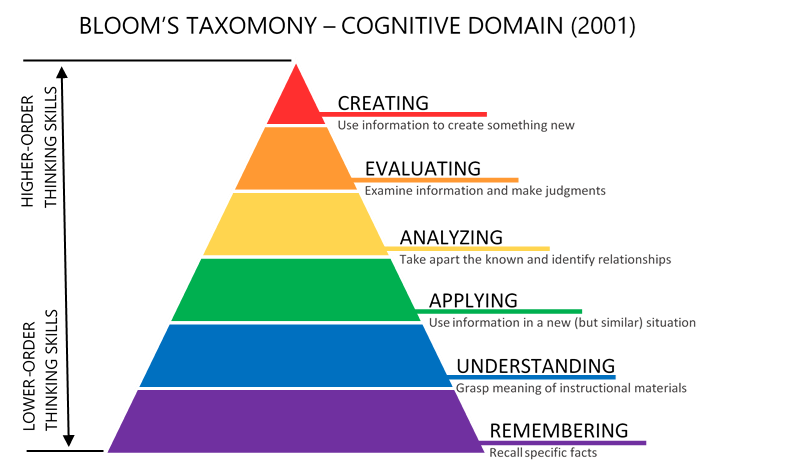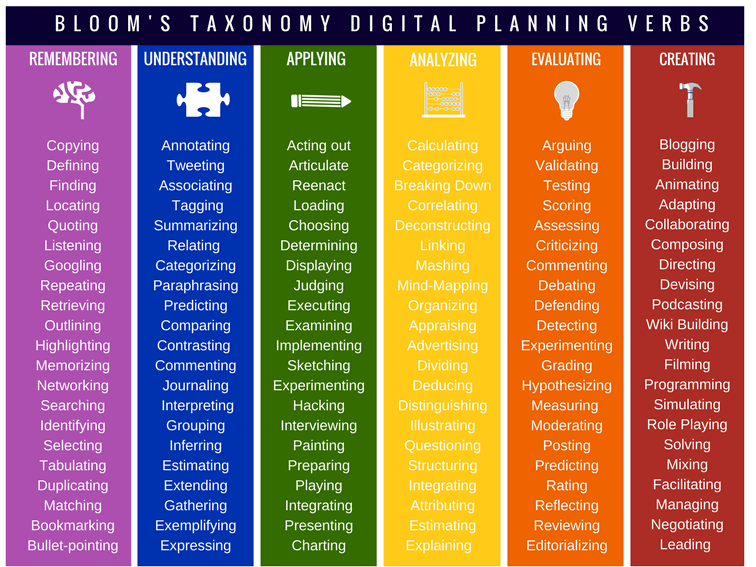Instructional design is the process a teacher goes through to plan and design a course, lesson, or session. Teachers need to take time to think through content, expectations, objectives, assessments, and pacing. To put it simply, you need to decide what you want students to know and be able to do at the end of your course, session, lesson, or activity and what you will ask them to do so you know they learned it? Below you will find helpful information to guide this process.

Goals provide direction, focus, and cohesion for your work with students.
Typically, goals do one or more of the following:
- Express the instructor's hopes or ideals for the overall educational experience students will have in a course.
- Provide an overarching framework for how the course sessions and learning objectives are connected toward a bigger goal.
- Describe what the course will do (vs. what students will be able to do).
- Describe longer-term aims that you want to work toward that you may not be able to measure in the short time you have students in your class.
- Convey the kind of learning experience you want to create for students (e.g. simulated or active learning experience)
Questions to prompt course goals:
- The main themes or ideas I will emphasize are…
- I want my course to develop my students in/as….
- The main questions I’m interested in are…
- I want my course to be place where…
If goals describe your hopes and aims for a course (instructor perspective), then learning objectives articulate the specific, measurable things students will know and be able to do upon leaving your course/lesson (learner perspective).
Sometimes called learning outcomes, learning goals, and/or competencies, learning objectives are at the heart of effective course design. Ultimately, it doesn't matter what you call them - as long as you can distinguish between the aims you have for your work in a course and those you have for what students will learn in the course.
Writing learning objectives helps you to design courses, lessons, and assignments more intentionally, with attention to specific, measurable skills. It also helps you structure learning in effective ways (breaking down complex tasks into simpler ones at first, moving from understanding something to applying or analyzing it, etc.).
What do you want students to know and be able to do? Identifying Learning Objectives for Your Course
Objectives should always start with “Students will be able to…” or SWBAT…
Course-Level Objectives
Identify some of the key takeaways for your course, the most important knowledge and skills students should leave with.
Lesson/Session Objectives
From there, you should be able to work backward, identifying what students will need to know and be able to do before they can do those more ambitious course objectives. Remember to build the objectives so that foundational objectives are achieved in the first lesson/session.
Example: If one of my course goals is learning to drive a car, then I have to have smaller learning objectives like, “Students will be able to parallel park.” Maybe that objective is too big yet so I will need to break it down further and work on the objective, “Students will be able to use mirrors to identify objects around the car.”
Writing Your Own Objectives
As you prepare to write learning objectives for your course, you will want to pay attention to desired content and skills.
Content: The core concepts, texts, formulae, etc. that are essential for students to learn in your course.
Skills: What you want students to be able to do upon leaving your course. This includes what they should be able to do with the content you'll cover, as well as so-called "cross-cutting skills" - skills that "cut across" disciplines, such as communication skills, reasoning skills, and so on.
Now it’s time to write!
Step 1: Return to the course goals you drafted earlier. Choose one of your main goals for the course. You'll use this goal to guide your development of specific learning objectives (course and lesson objectives).
Step 2: On a separate sheet of paper, answer the following question, writing as many responses as you can think of: What will students need to know and be able to do in order for you to know this goal has been met?
Step 3: Using the responses from Step 2 above, develop 1-2 learning objectives per one hour of class session. Consult Bloom’s Taxonomy and the related verbs to identify the best level and verbs for your desired learning objective.
Bloom’s Taxonomy is a tool that can help you write action verb objectives that are measurable:


Many educators use backward design when planning a course. That means they first design the end of course evaluation, where students demonstrate what they know and are able to do. Planning the end of course evaluation first can help you solidify the learning objectives. Then you will be able to design a course framework that includes lessons/activities that will help students eventually meet those objectives.
The word "assessment" can have more than one meaning in the course design process: it is the act of measuring or determining whether students have met the learning objectives you've set for them (verb). But it also can represent the activities you assign (noun), from formal essays and presentations to informal in-class writing exercises. In this latter sense, the "assessments" you design for your course (a.k.a., the assignments you ask students to complete) can serve as both the vehicle for learning and the vehicle for measuring learning. They can serve as your “check-points” to check on student understanding before the end of the course.
While you do not need to know every single assessment activity you'll assign in the early stages of designing your course, you should give some thought to major assignments - and their assessment criteria - as you design your class. Only then can you be sure that you are actually asking students to do work that will help them achieve the learning objectives you've set for them.
Types of Assessment
There are both formal and informal ways to assess student learning. Assessment activities can be formative, summative, and/or diagnostic.
Formative assessment happens in the moment and allows you to provide feedback for the purposes of forming (and sometimes re-forming) student achievement of the learning objectives you've set for them. An example would be when you provide feedback on an ungraded essay, for the purposes of student revision. Another example is asking certain questions during a lesson to check student understanding. Formative assessments can be formal or informal.
Summative assessment is usually "grading," providing a task that evaluates how well students perform compared to a set standard. Typically, summative assessments are formal assessments at the end of a course (rather than informal, in-class activities).
Diagnostic assessments (sometimes called pre-tests) are typically assigned at the beginning of a course, unit, or lesson. They are activities designed to uncover prior knowledge and skills. Diagnostic assessments (and even self-assessments) can provide rich information about where students are at the beginning of a learning opportunity. This information can help you tailor your course and instruction to the specific learners. It also can motivate students to be more intentional about the choices they make as learners, since it often can reveal to them gaps in their own understanding and knowledge base.
Designing Assessments for Your Course
As you design your course, it's important to be mindful of the kinds of assessments you might ask students to undertake. Think of all the activities and assignments that can help students learn the things you want them to learn and that can help you to assess whether students are, in fact, learning: in-class exercises, quizzes, formal essays, research projects, and presentations. At a minimum, you should give some thought to the formal assessments and assignments you'll include as you design your course.
Your task is to identify the activities and assessments that are most likely to contribute to the specific student learning you have in mind. Obviously, this task must be completed with an eye toward learning objectives. As discussed above, aligning your assessment activities with course goals and learning objectives is essential to effective course design.
One way to think about it is this: if you never ask students to do the kinds of activities that will facilitate the learning you want and demonstrate their achievement of your learning objectives, how will you know they have achieved them?
Tips for Designing Formal Assignments
Here are a few tips for creating formal assignments to suit your learning objectives:
Tip 1: Work backward from learning objectives and goals.
Determine the specific tasks and assignments that could help students learn the objectives and help you measure their learning.
Then, select the ones that seem best suited to your teaching situation and your course goals / learning objectives. Rather than asking, "what will be a fun activity?” ask instead, “what could students do to help them learn the objective? or “What could students do to show they know the objective?" By asking these questions, you ensure that you're discerning the best activities and assignments for the task, not simply defaulting to assignments that are typical for a course like yours.
For complex projects and assignments, ask yourself what students will need to know and be able to do in order to complete the work successfully. Then, break those things into smaller, more manageable tasks. (This will help you ensure that you are scaffolding in appropriate ways and covering the content and teaching the skills necessary for success on the larger assignment.)
Tip 2: Determine your assessment criteria as you design assignments (not afterward).
Now, write a description of the characteristics of the most successful versions of the assignment. Answer this question: What would be the signs that the student work is meeting the objectives? If you can describe the features of successful versions of the assignment, you can develop a rubric or other scoring guide to give students; this not only conveys how they will be assessed, but it also enhances their learning.
Then, try to write a description of the features you would see if the student work were falling short of meeting its objectives. Try to answer these questions: What would be missing? What would be there that shouldn't be? As before, if you can describe why the student work is not meeting its objectives, you can better articulate your assessment criteria.
Finally, use these descriptions to plan the lessons that will prepare students for the assignment and to develop rubrics or other tools for assessing how well they do.
Tip 3: Consider letting students design some of the assignments or choose how they will demonstrate their learning for specific learning objectives.
When students have to develop assignments, they internalize the learning objectives in a different way than when they simply complete assignments you've designed. Ask them to brainstorm possible tasks or activities that would demonstrate their achievement of specific learning objectives.
If letting students design their own assignments isn't appealing, consider letting them choose from a list of possible assignments. Provide students with the criteria you'll use to assess their learning, and a list of possible assignments / activities they could complete to demonstrate their learning. Give them the freedom to choose which ones best suit them. This act of choice can increase their motivation to learn and to complete the assigned tasks.
Active Learning is an approach with various methods/strategies for implementation. Click here to learn more about active learning strategies that work in medical education.
Remember that one way to do formative assessments is to stop and check student understanding during a lesson. Answer these questions when planning a lesson:
- Where will you stop teaching and check for student understanding?
- How will you check for student understanding? (Ask a question to the whole class and ask them to think/write, pair, share; give a whole-class poll; assign a quick write, etc.)
Opening –
- Introduce session topic and course/lesson goals
- Spark interest in the topic – maybe a story, a short video clip, ask students to share an experience associated with the topic. Or ask them what they know about the topic and what they want to know.
- Introduce student learning objectives
- Show agenda for the day
Closing –
It is important to close a lesson by returning to the objectives, allowing students time to reflect on their learning, and answering any remaining questions. Allow 5 minutes minimum for closing, but a good rule of thumb is providing 5 minutes per hour of lesson.
Once you have your course goals, student learning objectives, assessments and activities thought out, you need to figure out how and whether you can fit it all into your time allotted to teach.
It helps to go through the sequence of the lesson and envision how long each part will take. If you are new to teaching, this is a difficult step. It will take some experience before you can estimate how long things will take. Here’s a tip – it always takes longer than you think!
Opening (10 min)
Body of lesson
- Realistically how long will activities take?
- Consider some time for you to explain the activities well and answer questions
- Will students share out after each activity, or will you debrief a small group discussion? How much time will you give it?
Schedule breaks (10 minutes per 2 hours)
Closing (10 min)
